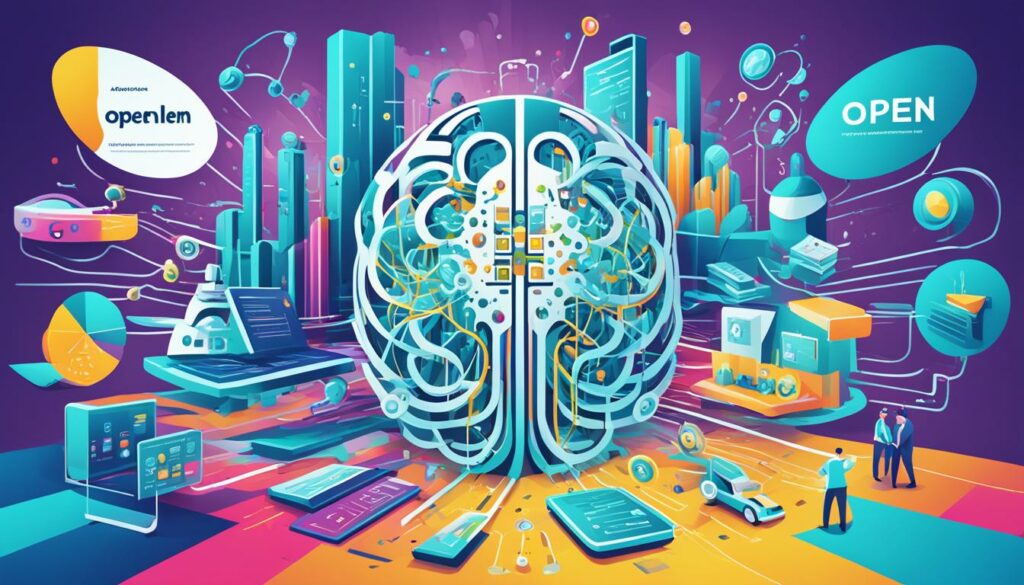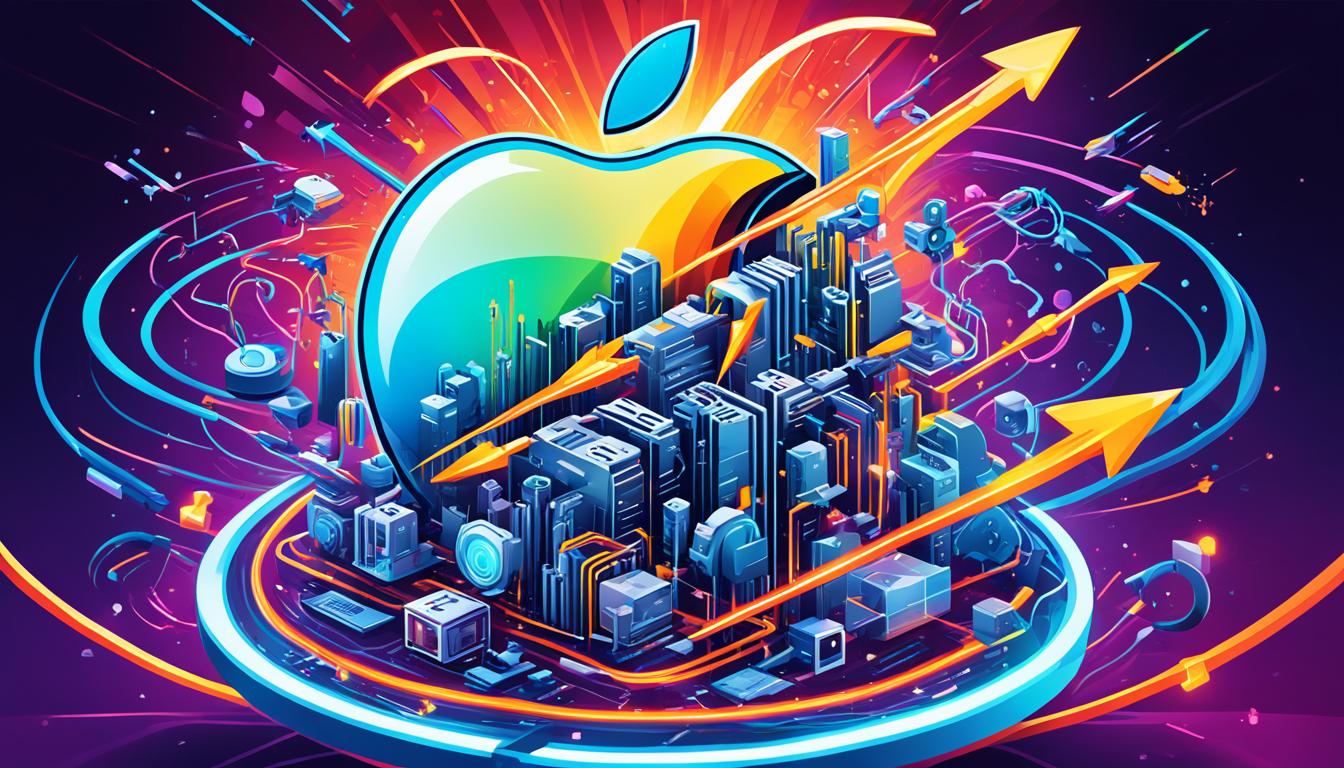Did you know Apple developed OpenELM, an open-source language model? It is made for AI processing right on your device. This means better AI performance and privacy on your Apple gear.
Apple’s OpenELm lets developers build cool apps and experiences. It opens up the full power of AI. And you can use it on your iPhone, iPad, or Mac.
Key Takeaways:
- OpenELM includes eight models to choose from. This makes it flexible for many AI tasks.
- OpenELM beats similar open-source models. It also needs only half the training data. This shows its efficiency and optimization.1
- Using AI on your device with OpenELM cuts down on wait times. This makes apps quicker and more responsive.1
- OpenELM also uses less data. So, your device can save power and keep running longer.1
- Apple has made CoreNet public. CoreNet is what they use to train OpenELM. This move supports innovation and openness.1
- With OpenELM, your data stays safe on your device. It doesn’t need to be sent to far-off servers.1
- OpenELM lets apps work smart, even without the internet. This ensures a smooth experience for the user.1
What is Apple’s OpenELM and How Does It Work?
Apple’s OpenELM is a group of compact language models made to work well on Apple devices. It uses Apple’s own silicon and neural engines to work smoothly with the device’s hardware and software. The OpenELM family includes eight models, differing in size from 270 million to 3 billion parameters2. They’re trained on data that’s open to the public to guarantee they perform well.
OpenELM’s design is made for efficient processing right on the device, without needing cloud servers. This means faster performance, less delay, and longer battery life1. Keeping AI processing on the device also boosts privacy and data security since your information doesn’t leave the device1. Plus, it reduces wait times for apps to respond, which is great even when the internet is slow or off1.
With OpenELM, apps can work smartly even without the internet1. Users get to use AI features no matter their internet situation. This broadens what apps can do and improves how users interact with them.
Apple has shared the CoreNet library that helps train OpenELM, including other models suited for Apple devices, with everyone1. This move towards openness helps developers use OpenELM to make better apps.
In summary, Apple’s OpenELM framework is key for advanced on-device AI. Its clever design, paired with Apple’s technology, helps create top-notch apps for Apple users.
Technical Details: Optimized for Apple’s Chips and Neural Engines
OpenELM, a strong AI tool for Apple gadgets, uses Apple’s chips and neural engines to work better and more efficiently. This means apps run faster and smarter on your Apple device.
Thanks to OpenELM, apps on Apple devices get smarter without delays1. This makes using your device smoother and quicker than before.
OpenELM not only boosts app speed, it also saves your battery. Since it processes data on your device, it doesn’t need to send data back and forth to the cloud1. This means you can use your device longer without recharging.
OpenELM also lets apps work without the internet1. So, you can translate languages or get writing help anywhere, even without WiFi.
OpenELM supports lots of different AI tasks1. It’s made to work with all kinds of smart apps, from understanding speech to recognizing what’s in photos.
Apple’s special OpenELM chip makes AI even better on Apple devices3. It can do a lot of cool things, like improve photos, understand how you use your device to make it personal, and help with health tracking and AR3.
OpenELM also keeps your information safe3. By planning to include a security feature, it ensures that your private data is kept private while processing AI tasks. This makes users more comfortable using smart features.
In conclusion, OpenELM is designed to make Apple gadgets run AI faster and more securely. With OpenELM, you get a better device experience, longer battery life, and the freedom to use AI anywhere. It’s all about powerful AI that respects your privacy.
Comparison: OpenELM vs. Comparable Open-Source Models
Apple has looked closely at OpenELM’s performance against other open-source models, like OLMo. These checks show how well OpenELM works, making it a top choice for new AI tools.
OpenELM needs just half the data to train but still outperforms others like OLMo1. This shows its top-notch efficiency, making it attractive for developers wanting powerful AI tools.
OpenELM also lets tasks run right on your device1. This skips the need for outside servers, giving a smoother and faster use.
Thanks to Apple’s work, OpenELM works great on their devices. Users get fast apps, less waiting, and their phone battery lasts longer1.
Privacy is key with OpenELM since it processes data on the device1. This lowers the chance of privacy issues or data theft. It’s a big plus in our world where data safety is huge.
With OpenELM, apps respond right away because there’s no delay1. Users get a fast experience without always checking in with cloud servers.
By processing AI work locally, OpenELM makes devices respond quicker. It also uses less battery1. That means your device works better and stays on longer.
OpenELM gives developers a way to train AI directly on devices1. They can update and improve AI models easily, without cloud training. This helps create apps that work just right.
Using OpenELM’s on-device AI does have hurdles, though. Developers have to make sure their apps and models use resources well1. They need a good grip on how the device works, which might take some learning.
| OpenELM Statistics | |
|---|---|
| Performance Advantage over OLMo | Requires only half the training data |
| On-Device AI Processing | Tasks can be handled directly on users’ devices |
| Optimized for Apple’s Hardware | Improved performance, reduced latency, and extended battery life |
| Enhanced Privacy and Data Protection | Processing data locally reduces privacy risks and potential data breaches |
| Minimized Latency | On-device AI processing leads to faster and more responsive applications |
| Improved Power Efficiency | Offloading AI workloads to local processors extends battery life |
| On-Device Training and Fine-Tuning | Developers can customize and refine AI models without cloud-based training |
| Optimization Challenges | Developers may need to optimize models and applications for efficient performance and memory utilization |
| Privacy and Security Measures | Apple has implemented robust measures in OpenELM to address data privacy concerns |
Key Benefits of Running AI Models Locally
Running AI models on devices locally has many benefits. It’s good for both developers and users. These benefits include better privacy, faster performance, longer battery life, and working offline.
Privacy: When AI processing happens on the device, your sensitive data stays safe. It doesn’t get sent to far-off servers. This offers more privacy and keeps your data secure, making you worry less1.
Processing on the device improves how well things work. Since AI models work right on the device, there’s less waiting. Things feel faster and smoother, especially for apps that need quick, right-on-time AI answers4.
Running AI models locally helps save battery life too. It moves AI tasks from the cloud to the device. This uses less power, which is very important for mobile devices. You get to use your device longer without needing to send data to the cloud constantly1.
Another plus is the offline feature. With AI working on the device, apps can still be smart without the web. This means users can enjoy AI-powered features even in places with bad or no web access1.
To wrap it up, the benefits of local AI models on devices are huge. They boost privacy, make things run better, save battery, and let you use apps offline. These upsides make local AI a top pick for those who want the best AI experience45.
Revolutionary Apps and Features Powered by OpenELM
OpenELM introduces a bunch of cool apps and features that change the game. With its AI that works right on your device, you get instant language translation, spot-on speech recognition, advanced picture understanding, and smart writing help. And guess what? You don’t even need to be online for this. So, whether you’re out exploring, busy at work, or just relaxing, OpenELM makes sure things go smoothly.
Think about talking easily with people from all over, thanks to live language translation. OpenELM breaks down language walls, helping us connect better. Its smart language models give spot-on translations as you chat, making talking and sharing across cultures easy. With OpenELM, our world gets a bit smaller and way more connected.1
OpenELM is also a star when it comes to understanding speech. It lets your gadgets turn spoken words into text with amazing accuracy. This means you can talk to control devices, dictate notes, and transcribe chats better than ever. OpenELM is changing the game in how we use voice, making gadgets more helpful and responsive.
Picture this: you control your gadgets just by talking to them. OpenELM’s speech tech gets not just the words but the meaning behind them. This makes using voice commands feel natural and easy. OpenELM is turning the power of speech into a real game-changer for getting things done.1
When it’s about computer vision, OpenELM is ahead of the pack. It helps gadgets see and understand the world with incredible detail. This means your devices can recognize objects, analyze faces, and get the scene, all to give you insights and help out. OpenELM is making our electronic friends smarter about the world around them.
OpenELM boosts how devices “see” and make sense of what’s around them. They can identify items, scenes, feelings, and much more. OpenELM’s vision tech opens up new chances for devices to be clever, aware, and able to offer better experiences in many areas.1
Smart writing helpers brought to life by OpenELM change how we write. They suggest ideas based on context, fix grammar, and even help generate content. This makes writing easier, better, and more fun.
Think of a writing buddy that gets your style and guides you. That’s what OpenELM’s clever writing helpers do. They offer ideas as you write, catch mistakes, and make sure your writing shines. With OpenELM, writing becomes smoother, more precise, and creatively rewarding.1
But OpenELM’s magic doesn’t just help out on a personal level. It’s set to shake things up in big fields like healthcare and education too. Imagine better patient care with clear language translation and teaching that meets each student right where they are. OpenELm is paving the way for big improvements in how we care, learn, and experience the world.
OpenELM’s effect goes far beyond just cool apps. In healthcare, it helps docs and patients chat in any language, making care more open and fair. Schools can use OpenELM for tutoring that really gets each student, making learning personal and effective. OpenELM’s big possibilities are about to change how we live and work for the better.1
| OpenELM Applications | Features |
|---|---|
| Language Translation | Real-time and accurate translation |
| Speech Recognition | Precise transcription and voice control |
| Computer Vision | Automatic object and scene recognition |
| Intelligent Writing Assistants | Context-aware suggestions and grammar correction |

Supercharging Existing Apple Services
Apple is stepping up its game with OpenELM, bringing new AI features to its services. These upgrades include advanced AI and improved privacy.
OpenELM in Apple services: With OpenELM, Apple’s services are becoming smarter and more responsive.
Context-aware Siri: Siri, with OpenELM, understands you better and works offline. It reacts to different situations, making your experience smoother and more custom.
Smarter photography: OpenELM helps Apple’s photo apps use AI for better pictures. This means smarter editing suggestions, better photos, and easy organization.
Real-time augmented reality: Thanks to OpenELM, Apple offers cutting-edge AR. Enjoy games, shopping, and tours with fast and smooth augmented reality.
“Integration with OpenELM takes Apple’s services to a whole new level, offering contextual intelligence, smarter photography, and real-time augmented reality experiences.” 1
Challenges in Adopting On-Device AI at Scale
Using on-device AI has its perks, but doing it on a big scale isn’t easy. There are hurdles we need to jump over for a smooth experience. These include model sizes, how much power they use, updating models, how much developers need to learn, and keeping everything safe and private.
Let’s talk about the size of AI models first. They’re getting bigger as they get smarter. This can lead to issues with storage and managing memory on mobile devices. It’s key to shrink these models so they fit and work well within phones’ limited space1.
Next up, power use is a big deal. Running AI on a phone uses a lot of energy, which can kill the battery fast. We need to figure out how to make AI use less power and manage heat better. This way, phones don’t overheat, and the battery lasts longer1.
Keeping AI models fresh and up-to-date is another thing to think about. As AI keeps getting better, we need to send these updates to devices smoothly. This makes sure everyone has the best and latest, avoiding any problems old models might cause1.
There’s also the challenge for the developers. Adopting on-device AI means they need to learn new stuff. They have to grasp new tools and ways of working to make AI work well on devices. Offering strong support and resources is essential for them to succeed1.
Lastly, we must balance being innovative with keeping everything secure. As AI becomes a bigger part of our lives, we have to make sure user data stays private and safe. Figuring out how to push boundaries while protecting everyone is a tough but important task1.
To really benefit from on-device AI, everyone from big companies to developers and researchers has to work together. They need to come up with solutions to these challenges. By joining forces and always striving to do better, making on-device AI work smoothly for everyone is possible.
Balancing Innovation with Privacy and Security
As tech gets smarter, we must balance innovation with privacy. This is important with on-device AI like Apple’s OpenELM.
OpenELM keeps data safe on your device. This stops the need to send private info to faraway servers. Because of this, OpenELM lowers the chance of privacy mishaps and data leaks1.
This AI tech also lets devices use less power. So, devices last longer and don’t use as much energy1. This makes gadgets work better without harming the environment.
OpenELM also makes devices respond faster1. This means apps work quickly, making things smoother for users.
Apple is known for keeping user data safe. OpenELM fits right into this by protecting data while using AI1.
There’s talk about OpenELM in iOS 18. It may bring new AI features, making Siri smarter without risking your privacy6.
To sum it up, OpenELM finds a smart way to mix new tech with privacy. It keeps data safe, saves power, works fast, and may bring even more cool features soon. OpenELM is all about safe and smart AI apps.
Conclusion
Apple’s On-Device OpenELM is a big step forward in AI on devices. It makes AI smarter and keeps your data private and more efficient on Apple devices. Working with Apple’s MLX, it lets powerful AI work on iPhones, iPads, and Macs without risking your privacy7.
OpenELM is more accurate than older models, with a 2.36% increase in accuracy. Apple offers eight different OpenELM models. These models range from 270 million to 3 billion parameters. They help with many AI tasks8. OpenELM is designed to work well on devices we use every day. It focuses on keeping your information safe and making AI smarter through special design strategies8.
Apple invests $1 billion yearly in AI and released OpenELM as something everyone can use5. It has a huge pre-training dataset. This dataset makes it really good at understanding and generating language5. OpenELM is better than other language models at many tasks. It uses new techniques to be more accurate and efficient5.
With this tool, developers can make AI apps that are safe and work right on your device7. Apple is pushing the limits of what mobile and smart apps can do. OpenELM is leading the way in AI, giving developers great tools to explore AI’s possibilities78.
FAQ
What is Apple’s OpenELM and how does it work?
How is OpenELM optimized for Apple’s chips and neural engines?
How does OpenELM compare to other open-source models?
What are the benefits of running AI models locally on devices?
What applications and features can be powered by OpenELM?
Can OpenELM enhance existing Apple services?
What are the challenges in adopting on-device AI at scale?
How does OpenELM prioritize privacy and data protection?
What are the key advantages of Apple’s OpenELM?
What advancements does Apple’s OpenELM bring to on-device AI?
Source Links
- https://www.justthink.ai/blog/apples-openelm-brings-ai-on-device
- https://bdtechtalks.com/2024/04/29/apple-openelm/
- https://www.apexearlycareers.com/post/apple-unveils-openelm-a-new-era-for-on-device-ai
- https://www.nomtek.com/blog/opportunities-on-device-ai
- https://ajithp.com/2024/05/04/openelm-apples-groundbreaking-open-language-model/
- https://medium.com/@learngrowthrive.fast/apple-openelm-on-device-ai-88ce8d8acd80
- https://medium.com/@zamalbabar/apple-unveils-openelm-the-next-leap-in-on-device-ai-3a1fbdb745ac
- https://ai.plainenglish.io/openelm-apples-leap-towards-open-source-language-models-e84597e027d2










